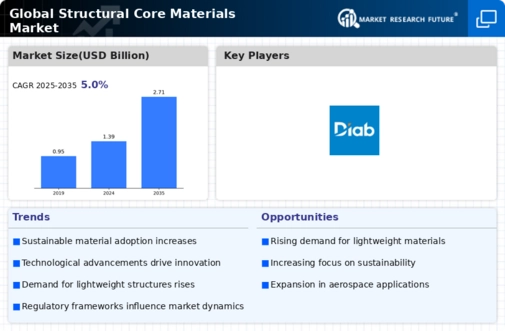Market Growth Projections
The Global Structural Core Materials Market Industry is projected to experience substantial growth in the coming years. With a market size expected to reach 1.39 USD Billion in 2024 and 2.71 USD Billion by 2035, the industry is poised for a robust expansion. The compound annual growth rate is estimated at 6.25 percent from 2025 to 2035, indicating a strong upward trajectory. This growth is driven by various factors, including technological advancements, increasing applications in renewable energy, and a shift towards sustainable practices. The market's dynamics suggest a favorable environment for stakeholders and investors.
Rising Demand for Lightweight Materials
The Global Structural Core Materials Market Industry is experiencing a surge in demand for lightweight materials, driven by the aerospace and automotive sectors. These industries are increasingly adopting composite materials to enhance fuel efficiency and reduce emissions. For instance, the use of structural core materials in aircraft components has been shown to decrease weight by up to 20 percent, leading to significant fuel savings. As a result, the market is projected to reach 1.39 USD Billion in 2024, with a growing emphasis on sustainability and performance. This trend is likely to continue, as manufacturers seek innovative solutions to meet regulatory standards and consumer expectations.
Increasing Applications in Renewable Energy
The Global Structural Core Materials Market Industry is witnessing increasing applications in the renewable energy sector, particularly in wind turbine manufacturing. The demand for lightweight and durable materials is critical for enhancing the efficiency and longevity of wind turbine blades. Structural core materials, such as honeycomb and foam cores, are being utilized to optimize blade design and reduce weight. This shift towards renewable energy sources is likely to drive market growth, as countries invest in sustainable energy infrastructure. The anticipated growth in this sector aligns with the overall market trajectory, suggesting a robust expansion in the coming years.
Shift Towards Sustainable Building Practices
The Global Structural Core Materials Market Industry is experiencing a shift towards sustainable building practices, driven by environmental regulations and consumer preferences. Architects and builders are increasingly seeking materials that minimize environmental impact while maintaining performance standards. Structural core materials, particularly those derived from renewable resources, are gaining traction in green building projects. This shift is reflected in the growing number of certifications for sustainable materials, which enhances market visibility and acceptance. As sustainability becomes a priority in construction, the demand for eco-friendly structural core materials is likely to rise, further propelling market growth.
Growing Investment in Infrastructure Development
Growing investment in infrastructure development globally is significantly impacting the Global Structural Core Materials Market Industry. Governments and private entities are increasingly allocating funds for the construction of bridges, buildings, and transportation systems, which require high-performance materials. Structural core materials are favored for their strength-to-weight ratio and durability, making them ideal for modern construction projects. For instance, the use of composite materials in bridge construction has been shown to extend service life and reduce maintenance costs. This trend is expected to bolster market growth, with a projected compound annual growth rate of 6.25 percent from 2025 to 2035.
Technological Advancements in Manufacturing Processes
Technological advancements in manufacturing processes are playing a pivotal role in the Global Structural Core Materials Market Industry. Innovations such as automated fiber placement and advanced resin infusion techniques are enhancing the efficiency and quality of core material production. These technologies not only reduce production costs but also improve the mechanical properties of the final products. For example, the introduction of 3D printing in core material fabrication allows for complex geometries that were previously unattainable. As these technologies evolve, they are expected to contribute to the market's growth, with projections indicating a market size of 2.71 USD Billion by 2035.












Leave a Comment